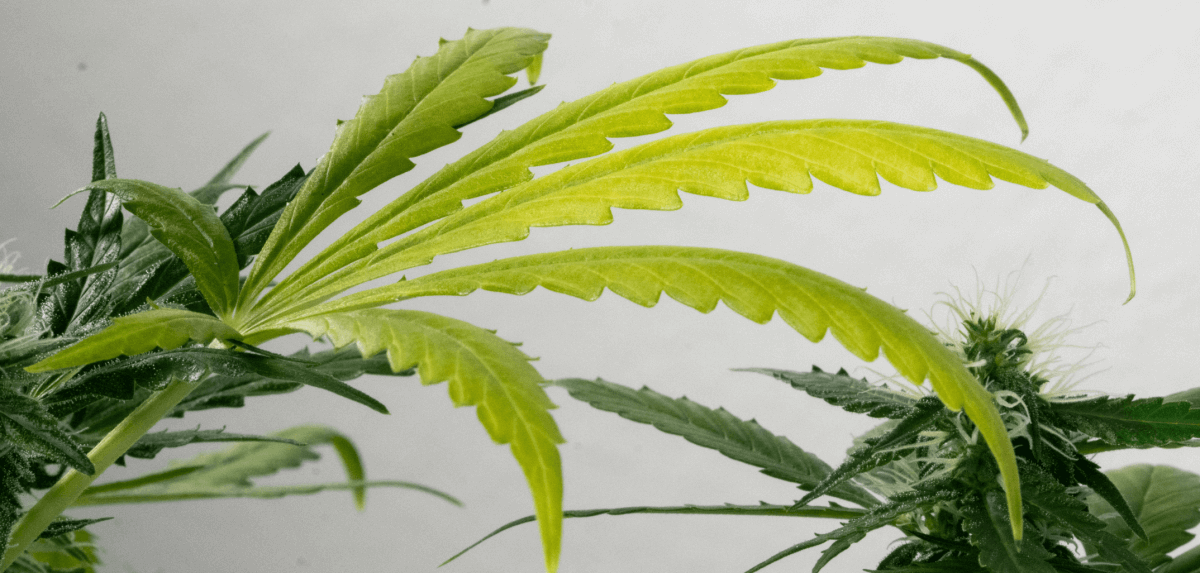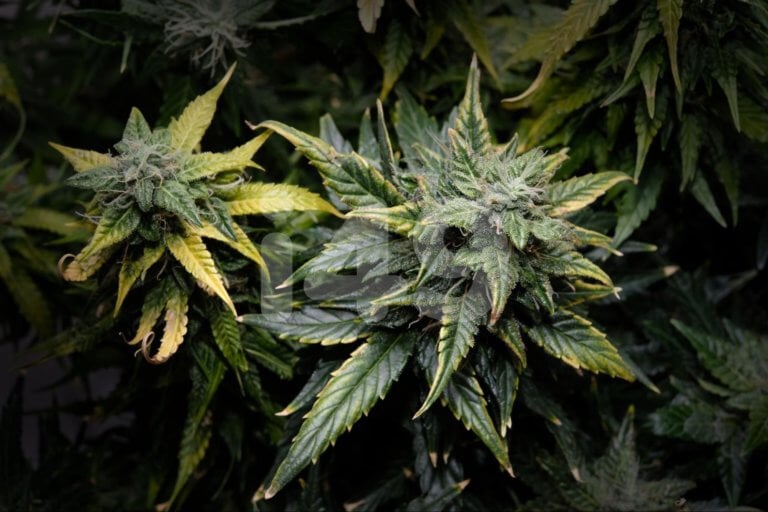Buying cannabis seeds is the first step in your exciting cultivation journey. Along the way, you may run into obstacles, but armed with the correct info, these become challenges to overcome. One of the most common of these is nitrogen deficiency in weed.
Over the following sections, we’ll show you how to identify and solve this frequently encountered setback.
Let’s get to it.

What does nitrogen do for cannabis plants?

All plants, including cannabis, require a host of nutrients for optimal growth. The most critical of these are the macronutrients nitrogen (N), phosphorus (P), and potassium (K). These are collectively abbreviated and displayed on fertilizers as an NPK ratio.
You’ll find a range of NPK ratios on various fertilizers. When it comes to nitrogen, nutrients for weed aimed at vegetative growth are sure to contain a significant amount of N.
The importance of nitrogen during vegetative growth cannot be understated, as it facilitates several essential plant functions. A nitrogen deficiency in cannabis prevents the following processes from being carried out optimally:
- Plants use nitrogen to produce the green pigment in their leaves called chlorophyll. This compound is vital for photosynthesis. This process uses light to convert water and carbon dioxide into glucose.
These photosynthesized sugars provide energy and go towards the production of cellulose and starch.
- Plant proteins are created using amino acid building blocks. These proteins, in turn, form not only the structural components of crops but also enzymes and hormones essential for healthy growth.
- Nitrogen is also a key component in producing nucleic acids such as DNA which are necessary for growth and reproduction. Without these acids, plants may experience a wide range of issues.
Now that you understand this mineral nutrient’s importance, let’s move on. First, we’ll look at identifying the signs of a lack of N before learning what steps to take to solve the problem.
How to identify nitrogen deficiency on weed plants

With this nutrient serving many roles, a shortage has the potential to cause lots of issues.
Before looking at the symptoms of nitrogen deficiency in weed, it’s essential to understand its properties. This substance is a mobile nutrient, so plants can move it to the areas it needs most.
A nitrogen deficiency poses the most significant threat during veg and is rarely a cause for concern in the flowering stage. Plant requirements change as efforts move toward bud production, and demand for N drops significantly.

Fertilizers designed for the flowering phase usually contain more P and K, as these are in higher demand during bloom. Some formulations for the late flowering period might not have any nitrogen whatsoever.

Fresh new foliage toward the canopy is rarely lacking in N. As a result, older, larger leaves toward the bottom of the plant will be the ones to display symptoms first. This behavior lets you rectify the problem before it gets too bad.

It’s natural for older foliage to yellow off and wilt in the weeks leading up to harvest, especially after flushing. Many growers consider it a positive sign that their crops aren’t retaining high amounts of nutes, resulting in tastier buds.
Unless you observe progressive signs of nitrogen deficiency during early flowering, don’t stress over minor yellowing on lower leaves. These have performed their function and are no longer critical as the plants bloom.
With the above knowledge in hand, here’s what you’ll need to keep an eye out for during cultivation:
- Yellow Leaves: A cannabis nitrogen deficiency causes your crops to prioritize delivery of what little they have to newer growth. Older foliage is left without N and is unable to produce chlorophyll.
Leaves turn a pale lime green before displaying yellow discoloration at the tips.

- Progressive Discoloration: Unlike leaf septoria, with its yellow spots, N deficiency is progressive. Entire fan leaves are drained of their vibrant green, leading to the following symptom. Catch the signs early, and nitrogen deficiency in weed is much easier to deal with.

- Wilting Leaves: Once the discolored foliage is robbed of all its chlorophyll, it begins to wilt, die, and fall from the plant.

- Stunted growth: A continuing lack of nitrogen results in the entire plant growing much slower than it should. New leaves come in small and wispy, and progress crawls.
- Clawing: Weakened leaves curl in on themselves and take on a claw-like appearance. Remember that this symptom may have other causes, such as nitrogen toxicity, nutrient burn, pests, or root rot.
Now that you know what to look for, let’s discover how to fix nitrogen deficiency in weed plants.
How to fix nitrogen deficiency in weed plants
A shortage of nitrogen is one of the most common cannabis deficiencies. Use these tips to treat the problem and get your crops back on track for a healthy harvest.

Check pH levels
One of the most common mistakes beginner growers make is failing to monitor their pH levels. If the medium you’re using doesn’t have the right balance, your plants can’t absorb the required nutrients effectively.
Regularly check your medium’s pH, maintaining it within the optimal range of 5.5–6.5. An incorrectly balanced medium is one of the causes of nitrogen deficiency in cannabis plants.

Adjust nutrients
If the symptoms persist, it’s time to adjust your feeding solution. One of the next leading causes of N deficiency is using old, unsuitable soil leached of all nutrition.
Short of repotting your plants, the next best course of action is to increase nutrient amounts.
Most fertilizers for weed aimed at the vegetative stage contain plenty of nitrogen. Follow the manufacturer’s instructions, and don’t go overboard. Adjust your dose gradually to avoid causing toxicity or nutrient lockout.
Prune affected leaves
Pruning is cutting back foliage that’s already yellowed off reduces your plants’ overall requirements. With less demand, crops have a chance to recover using the tips mentioned earlier.
Action these three guidelines, and you should start seeing your plants recover within a week or two. Nitrogen deficiency in cannabis only becomes a significant setback if it’s allowed to develop unchecked.
As with many obstacles to cultivation, prevention is better than cure. You could avoid most problems like this by using high-quality cannabis seeds and materials and remaining attentive to your plants’ needs.
It’s also important to reiterate that nitrogen deficiency during flowering, especially toward the end of this period, is nothing to worry about. It’s perfectly natural to see some leaves yellow off and wilt as energy shifts toward plumping up those juicy buds.
Nitrogen toxicity in cannabis: More is not better
Sometimes, growers identify a marijuana nitrogen deficiency, begin to panic, and in their attempt to solve the problem, overcorrect. With high N levels in most potting media and fertilizers, overdosing your crops is easily done.
Provide too much N, and you’ll end up with nitrogen toxicity. An excess of N results in excessive overgrowth of leaves, weakened stems, and a diminished rate of photosynthesis.

Ultimately, yields get negatively impacted, and it can also result in the production of malformed, low-quality flowers.
Plants affected by this issue display the following symptoms:
- Discoloration: Foliage begins to turn an unusually dark shade of green. Depending on the strain, leaves may look and feel glossy.
- Leaves edges are curling up: Leaf tips turn up and in, creating the appearance of a curling. This curling of leaves could also be a case of N deficiency, so be careful not to misdiagnose.
- Yellowing leaves: As with a shortage of nitrogen, too much can cause yellowing and browning of leaves that subsequently wilt and fall off. This symptom is also found in N deficient plants and may confuse growers unfamiliar with the problem.
- Nutrient burn: Elevated N levels in the foliage may cause nutrient burn along its edges. Of course, this problem may be caused by an excess of minerals other than nitrogen.
- Stressed crops: Plants absorb more water as a survival response. If that water contains toxic levels of nitrogen, the problem could worsen.
- Spotting: Leaves begin to display yellow or brown spotting, dying off soon after. Be wary of misidentifying this symptom, as it may result from various other issues.
Common symptoms of nitrogen toxicity are sometimes mistaken for a deficiency, leading to growers compounding the issue. The key is to remain calm, try to confirm the problem, and take appropriate action incrementally.
Be attentive, keep calm, and grow weed
A weed plant nitrogen deficiency is alarming for any home grower, but it’s not the end of your crops. Regularly monitor your plants, maintain optimal pH levels, and use a nutrient-rich medium, soil or hydroponics; you’ll likely avoid the issue entirely.
If you see signs of a nitrogen deficiency, keep calm and implement our simple tips to return your crops to perfect health.
If you’re new to growing and reading up on the subject, you’re in the right place. Check out our other articles, from the best germination methods to when to harvest cannabis.
Once you’ve done your research, why not head to our store, pick up a pack of high-quality seeds and start your adventure? Some of the best strains on the planet are waiting to be sown and cared for by you.













